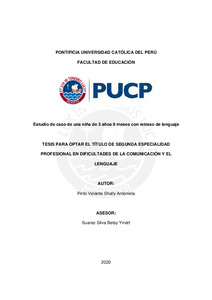| dc.contributor.advisor | Suarez Silva, Betsy Yinett | |
| dc.contributor.author | Pinto Velarde, Shally Antonieta | |
| dc.date.accessioned | 2021-06-24T18:53:51Z | |
| dc.date.available | 2021-06-24T18:53:51Z | |
| dc.date.created | 2020 | |
| dc.date.issued | 2021-06-24 | |
| dc.identifier.uri | http://hdl.handle.net/20.500.12404/19545 | |
| dc.description.abstract | El lenguaje es una facultad humana, un código socialmente compartido, que sirve para representar
conceptos mediante la utilización de símbolos y bajo ciertas reglas necesarias para entablar una buena
interacción social, escolar y familiar. Su adquisición se da principalmente en los primeros años de vida,
encontrándose, en ocasiones, dificultades en su desarrollo, lo cual afecta el desenvolvimiento del niño en
su entorno. El objetivo del presente estudio de caso es diseñar un plan de evaluación e intervención
acorde a las necesidades que presenta una niña de 3 años 8 meses con Retraso de Lenguaje,
predominantemente expresivo. El retraso de lenguaje se caracteriza por centrarse fundamentalmente en
el aspecto expresivo, evidenciándose alteraciones fonológicas y limitación del léxico, además el lenguaje
oral se inicia con 1 año o 1 año y medio de desfase, siendo el perfil lingüístico no esperado a su edad. Se
aplicó el modelo de intervención híbrido, a través del cual la especialista planteó los objetivos según el
interés de la niña, proponiendo actividades lúdicas y experiencias directas. Los resultados evidencian la
adquisición del fonema /s/, de forma aislada y al inicio de la sílaba y la palabra, así como la emisión de
palabras de 3 y 4 sílabas respetando su metría. Además, se superó la asimilación de /m/ por /p/.
Asimismo, logró elaborar oraciones de acuerdo a la estructura “Sujeto+verbo+objeto” y seguir
instrucciones encadenadas de dos acciones relacionadas entre sí. Se concluye que el plan de
intervención aplicado permitió a la niña obtener avances en los componentes programados,
morfosintáctico y fonético fonológico | es_ES |
| dc.description.abstract | Language is a human faculty, a socially shared code, which serves to represent concepts through the use
of symbols and under certain rules necessary to establish a good social, school and family interaction. Its
acquisition occurs mainly in the first years of life, occasionally encountering difficulties in their
development, which affects the development of the child in its environment. The objective of this case
study is to design an evaluation and intervention plan according to the needs of a 3-year-8-month-old girl
with Language Delay, predominantly expressive. Language delay is characterized by focusing primarily on
the expressive aspect, showing phonological alterations and limitation of the lexicon, in addition to the
language. Oral starts with a 1 year or 1 year and a half lag, the linguistic profile being unexpected at their
age. I know applied the hybrid intervention model, through which the specialist raised the objectives
according to the interest of the girl, proposing recreational activities and direct experiences. The results
show the acquisition of the phoneme / s /, in isolation and at the beginning of the syllable and the word, as
well as the emission of words of 3 and 4 syllables respecting their metrics. Furthermore, the assimilation of
/ m / by / p / was exceeded. Likewise, he managed to elaborate sentences according to the structure
"Subject + verb + object" and follow chained instructions of two related actions. It is concluded that the
applied intervention allowed the girl to obtain progress in the programmed components, morphosyntactic
and phonetic phonology. | es_ES |
| dc.language.iso | spa | es_ES |
| dc.publisher | Pontificia Universidad Católica del Perú | es_ES |
| dc.rights | info:eu-repo/semantics/closedAccess | es_ES |
| dc.subject | Transtornos de habla en niños--Evaluación--Estudio de casos | es_ES |
| dc.subject | Niños--Lenguaje | es_ES |
| dc.subject | Trastornos del aprendizaje (Educación) | es_ES |
| dc.title | Estudio de caso de una niña de 3 años 8 meses con retraso de lenguaje | es_ES |
| dc.type | info:eu-repo/semantics/bachelorThesis | es_ES |
| thesis.degree.name | Segunda Especialidad en Dificultades de la Comunicación y Lenguaje | es_ES |
| thesis.degree.level | Título Profesional | es_ES |
| thesis.degree.grantor | Pontificia Universidad Católica del Perú. Facultad de Educación | es_ES |
| thesis.degree.discipline | Dificultades de la Comunicación y Lenguaje | es_ES |
| renati.advisor.dni | 43061268 | |
| renati.advisor.orcid | https://orcid.org/0000-0001-5196-8423 | es_ES |
| renati.author.dni | 29707058 | |
| renati.discipline | 141049 | es_ES |
| renati.juror | Chavez Galvez, Zandy | es_ES |
| renati.juror | Sing Ore, Angèlica María | es_ES |
| renati.juror | Ortiz de Orue Aliaga, Julia Vanessa | es_ES |
| renati.level | https://purl.org/pe-repo/renati/level#tituloSegundaEspecialidad | es_ES |
| renati.type | https://purl.org/pe-repo/renati/type#tesis | es_ES |
| dc.publisher.country | PE | es_ES |
| dc.subject.ocde | https://purl.org/pe-repo/ocde/ford#5.03.01 | es_ES |





